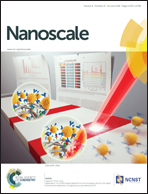What controls open-pore and residual currents in the first sensing zone of alpha-hemolysin nanopore? Combined experimental and theoretical study†
Abstract
The electrophoretic transport of single-stranded DNA through biological nanopores such as alpha-hemolysin (αHL) is a promising and cost-effective technology with the potential to revolutionize genomics. The rational design of pores with the controlled polymer translocation rates and high contrast between different nucleotides could improve significantly nanopore sequencing applications. Here, we apply a combination of theoretical and experimental methods in an attempt to elucidate several selective modifications in the pore which were proposed to be central for the effective discrimination between purines and pyrimidines. Our nanopore test set includes the wild type αHL and six mutants (E111N/M113X/K147N) in which the cross-section and chemical functionality of the first constriction zone of the pore are modified. Electrophysiological recordings were combined with all-atom Molecular Dynamics simulations (MD) and a recently developed Brownian Dynamics (BROMOC) protocol to investigate residual ion currents and pore–DNA interactions for two homo-polymers e.g. poly(dA)40 or poly(dC)40 blocking the pore. The calculated residual currents and contrast in the poly(dA)40/poly(dC)40 blocked pore are in qualitative agreement with the experimental recordings. We showed that a simple structural metric allows rationalization of key elements in the emergent contrast between purines and pyrimidines in the modified αHL mutants. The shape of the pore and its capacity for hydrogen bonding to a translocated polynucleotide are two essential parameters for contrast optimization. To further probe the impact of these two factors in the ssDNA sensing, we eliminated the effect of the primary constriction using serine substitutions (i.e. E111S/M113S/T145S/K147S) and increased the hydrophobic volume of the central residue in the secondary constriction (L135I). This pore modification sharply increased the contrast between Adenine (A) and Cytosine (C).


 Please wait while we load your content...
Please wait while we load your content...